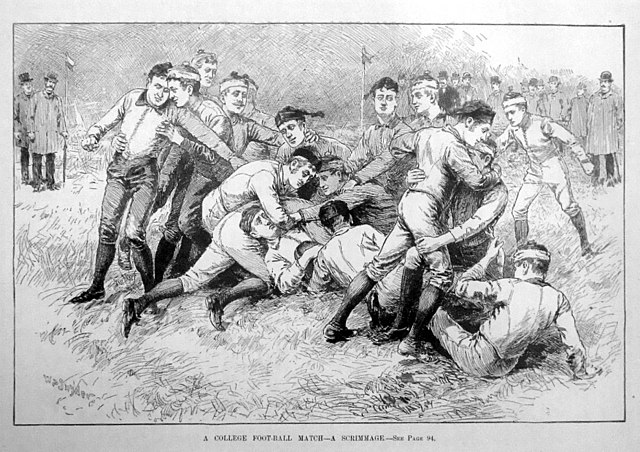
An 1885 unknown artist rendering of a football from scrimmage, courtesy Wikimedia Commons collection.
Debate at the specially convened football rules meeting in November 1884 showed a need to define the authority of the referee and the two judges... This would be the major assignment of the next meeting of the football minds at New York’s Fifth Avenue Hotel on February 7, 1885. At this convention Harvard was forced to withdraw from the association as the sport was abolished by the institution due to a decision by the school’s faculty. The universities of Pennsylvania and Wesleyan though were more than willing to fill the void left by Harvard’s departure as they applied for membership in the association.
Public interest grows
The acceptance of Pennsylvania and Wesleyan to the association along with interest from the public prompted the Harvard resignation to be short lived. Public interest grew when Yale and Princeton played in 1885 on college grounds for the first time in the series history. In previous years the game between these two schools was played in New York City but this time the game was scheduled to be played in New Haven. For the first time as a result of this site change the game of football became a social event in which many ladies attended. This made attendance figures spike dramatically over previous games, because not only were there men who loved to watch the athletic event there were men who attended to watch members of the fairer sex as well as the young ladies themselves.
.jpg)
An 1885 team photo of the Yale University team taken by an unknown photographer, courtesy Wikimedia Commons
This game in 1885 between Yale and Princeton also had a very dramatic ending where Princeton snatched victory over their opponents in the last moment of the game on a game winning run by Henry Lamar. Trailing 5–0, Princeton dropped two men back to receive a Yale punt. The punt glanced off one returner's shoulder and was caught by the other, Henry "Tillie" Lamar, on the dead run. Lamar streaked down the left sideline, until hemmed in by two Yale players, then cut sharply to the middle of the field, ducking under their arms and breaking loose for the touchdown. It was a 90-yard punt return by Tillie of Princeton. The Lamar punt return furnished the most spectacular ending to any football game played to that point in time and showed what an exciting game football could be for spectators.This fantastic finish left an impression on the public viewing football as a very exciting spectator sport.
The Harvard faculty too got caught up in all of the excitement and by year’s end decided to revoke their earlier abolishment of the sport at the Harvard campus.
The Ref’s role
This meeting established a rule where as a referee had the authority to say a ball was down or dead. Other rules in this session stated that the contestants in a championship game had to mutually decide upon the referee for the game who would have absolute power in all rulings and they also must pay him for his services. These duties of the referee were established in writing. “The referee shall take out time for unnecessary delay. He shall decide disputed points, and shall for intentionally delaying the game or off-side play give, for the first offense, one point to the opponents, and, for the second offense, one point more to the opponents and dismissal of the offender from the field.” It added that two points would be added to the opponents of teams that “slugged” or intentionally went off-sides. The referee was also assigned the task of declaring a forfeiture of the game should a team refuse to play after the referee ordered them to start play. Another rule stated, “No delay arising from any cause whatsoever, shall last longer than five minutes.”
_(14780821094).jpg)
An 1885 unknown artist rendering of a football from scrimmage, courtesy Wikimedia Commons collection. 1885 book on Athletics at Cornell and is titled "Outing" and was contributed and researched by the Tisch Library and the Boston Library Consortium Member Libraries
The judges’ position
As discussed in an earlier segment of this series the referee was accompanied on the field by two judges. Overtime the judges too were developing roles that factored into the rules of the game and how it was played. The 1876 rules said that a judge would be assigned to each sideline. The idea sprung forth from Rugby rules where as the captains of each side would argue over disputed plays on the field. American innovators of football decided to instead give this rule argumentation to on field special advocates of each team. These team advocates called judges were basically team lawyers that were on the field. Each team could select its own judge to plead calls to the referee who had the final say as to the claims and disputes of the judges.
What occurred was that the judges transformed into selections that had strong argumentative and debate skills as well as deep knowledge of the rules. There are many interesting stories that came out of this relationship of officials. This relationship and the many delays that the arguments caused in the game resulted in the demise of the judge positions. The rules of the 1885 conferences pretty much abolished the judge positions and gave all authority of calling the game to the referee.
This was sort of an ironic but sensible transition. The rules were increased and became more stringent and yet the amount of officials decreased. It made sense though because arguments were decreased as one man became the authority of what was happening in the game, the referee.
Please find the continuation of this story in part 9 titled, “The First Thanksgiving Day Game,” of the Dispatch’s football history lesson coming soon, right here on PigskinDispatch.com, your place for the good news about football.
We are able to give this in depth look from so long ago in history by careful research. Using someone who was contemporary to the period is the best source. So a very special shout out to our main source of reference information for this article is from Parke H. Davis in his 1911 book Football-The American Intercollegiate Game.




.jpg)
_(14780821094).jpg)



